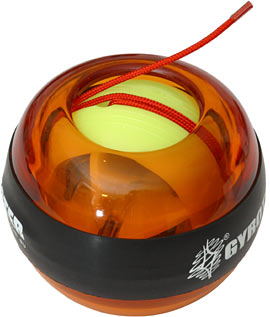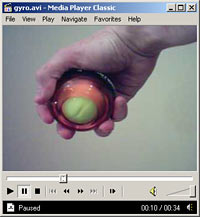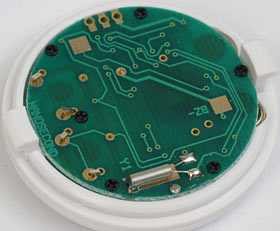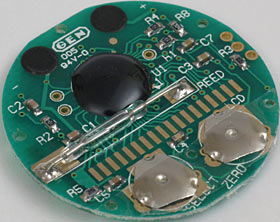
GyroTwister and Powerball
Review date: 15 August 2003.Last modified 03-Dec-2011.
No nerd-nest is complete without a gyroscope.
(And, by preference, a radiometer, and a Klein bottle, a levitating globe, a home-made pipe organ, and various other purchased and constructed science toys, some more violent than others. But I digress, however parenthetically.)
A gyroscope is a spinning top on bearings. It's got some sort of stationary frame around a weighted rotor, so you can hold it while it's spinning. That lets you experiment with the peculiar properties of a rapidly rotating object. You can balance an ordinary toy gyroscope on a pinpoint, or on a piece of string, for instance.
The oddest property of a gyroscope is precession. If you try to change the orientation of the gyro's axle, it'll "fight" you, with its own force at a 90 degree angle to your effort. This property makes itself obvious whenever you're dealing with a rapidly rotating object. You can, for instance, use it to tell you whether a hard drive is spinning when you can't tell by listening, provided said drive isn't screwed into a computer case at the time.
Precession is harnessed by the GyroTwister in a peculiar and, superficially, magical way. This is the weirdest, and the coolest, gyro-toy I've ever seen.
The GyroTwister looks, at a glance, like a simple redesign of the basic toy gyro idea. There's a rotor (made of plastic, with a metal ring inside it for weight), and there's a pseudo-spherical clear plastic frame around it, with a hole that part of the rotor peeks out of. There's a removable rubber grip ring around the toy's equator.
The whole thing weighs about 210 grams (7.4 ounces). It's a bit more than 70mm wide, counting its rubber ring, and a bit less than 60mm tall.
To start the GyroTwister, you use a cord, as with most other toy gyros (fancier models have electric spin-up motors). You get two cords in the box. They each have a shoelace-style plastic sleeve on each end, which you poke into a hole in the side of the rotor to anchor the cord. Then you wind the cord around the rotor, and yank it off to get the thing going.
At this point, the GyroTwister looks like a regular gyroscope, but a very boring and badly designed one. You don't wind the starter cord around the middle of your rotor, where it's biggest! That'll give you a miserably low starting speed! You're meant to wind the thing around the rotor's axle, surely. Aren't you?
Not in this case. The GyroTwister's cord is just a starter. You get the thing up to several thousands of revolutions per minute by "pumping" it.
To pump your GyroTwister, you turn it so that you're forcing the rotor to precess. The instructions tell you to turn it as if you were trying to swirl the ice in a drink, and that's a good hint; you can point it any way you like, though, and you can swirl it either way, too.
If you force the GyroTwister to be level, or hold it loosely, the rotor makes a chattering sound and spins as you'd expect a gyro to spin. If you hold it firmly and swirl it, though, the whole rotor not only spins around its axle, but the axle itself turns around and around, much more slowly than the main rotor spin. It's as if there was a mystic second axle, stuck through the rotor at right angles to the actual axle, pointing out of the hole.
The direction of the slower spin is determined by the direction of the rotor's precession; swirl one way and it turns that way, swirl the other way and it reverses. The faster you swirl, the faster the rotor turns, and the louder the noise of it turning gets; the GyroTwister's vane-spoked rotor makes quite a racket at speed. It vibrates noticeably, too; it isn't quite as precision-balanced as it might be. But the big news is the precession force, always at an angle to whatever direction the thing's actually moving. Suddenly, you're getting quite a wrist workout.
All of this is easier to explain with a video clip than with words, so here one is (MJPEG-compressed AVI format). It ought to give you some idea of what's going on, despite the low frame rate.
Keep swirling and the GyroTwister will keep spinning, until such time as you lose interest, drop it, or die.
The fact that you can stop the GyroTwister from running down is quite remarkable, and puts it well ahead of every other gyro-toy I've seen. The battery-powered version of the Levitron will spin for a long, long time (once you set the fussy little blighter up, that is...), but all it does is sit there and hover. The GyroTwister, you can play with, and pass around.
WTF?!
I could, at this point, finish up by saying that the GyroTwister is a fine toy, may also have real value as an exercise device, and is well worth the $AU49.95 that the local distributors here in Australia are charging for it.
I wanted to find out how the thing works, though.
How is your swirling being converted to more rotor speed? And why can you just start swirling the other way whenever you like and have the thing click over to turning the other way? The rotor's principal spin doesn't change direction, thank goodness (though stranger things have happened...), but it'd almost make more sense if it did.
Troll the various sites selling GyroTwister-ish devices (it's also sold as the "Powerball" and the "Dynabee"/"SuperGyro", for instance; everyone seems to insist that their version is "the original", and I think they're all the same thing under different names) and you'll find a variety of how-it-works explanations that don't make a lot of sense. Lots of confusing misuse of terms for weight, power, energy and force, not much information.
The explanation is actually fairly simple.
Taking the rubber grip ring off reveals the bearing assembly, such as it is. The rotor shaft simply sits in an equatorial groove around the inside of the casing. There's no complicated gimbal arrangement; the axle of the GyroTwister rotor just rides in the groove.
There are two keys to understanding what's going on.
One: The groove is wider than the axle. The rotor can rattle up and down a bit inside its shell.
Two: When the axle touches either side of the groove, there's a lot of friction. There aren't any gear teeth there, but the interface between axle and groove behaves rather as if there were. It's very "grabby". For this reason, it's especially surprising when you spin the thing up and it starts its slow rotation; when the rotor's stationary, it's not obvious that it even can turn that way.
The GyroTwister FAQ warns you not to lubricate the thing. If you get rid of the friction, the GyroTwister won't work any more.
So. When the rotor's not spinning, the axle sits peacefully on the lower side of the groove. The same thing happens, after a fashion, when the GyroTwister's spinning but not being tilted. Then, it chatters and buzzes. This is because the two ends of the axle are both trying to rest on the bottom of the groove, but they're fighting each other; they're trying to slow-turn the rotor assembly in opposite directions. This results in the axle-ends just doing their best to cut little notches in the lower edge of the plastic groove. The instructions warn you not to let this happen too much.
When you tilt the GyroTwister, though, precession stops gravity from being the force that decides what the axle does. Precession causes the rotor to try to turn vertical, but it can't do it, because the ends of its axle are constrained by the groove. One end of the axle's trying to go up, the other's trying to go down, and so one axle end is mashed against the top side of the groove, while the other end's mashed against the bottom side.
Now, because opposite sides of the axle are in contact with opposite walls of the groove, they're both driving the rotor to slow-rotate in the same direction. So the GyroTwister turns. Clockwise or anticlockwise, depending on which way you're swirling it.
And, because the axle has a lot of friction with the groove edges, if you swirl a little faster than the speed at which the rotor's trying to slow-turn, you'll speed it up.
The ratio between the speed of the rotor's slow rotation and the speed of its fast gyro-rotation is determined by the ratio between the circumferences of the axle and of the groove. The axle shaft seems to have about a 2mm diameter (meaning about a 6.3mm circumference), and the ring's circumference is about 200mm. So for every complete slow rotation the rotor makes, it has to make about 32 fast rotations, assuming no slip.
I timed myself swirling the GyroTwister at a not-too-wrist-punishing speed, and got 4.6 swirls per second. Assuming the above numbers are perfectly accurate (which they aren't), that works out at 8832 revolutions per minute. Which is the kind of speed that the promotional material says you're supposed to be able to spin the thing at.
Getting precise
If you want to know exactly how fast you can spin a Gyro-Thingy, then you want this deluxe version.
It's a Powerball (non-Australian site here), it sells for $AU79 plus $AU8.95 shipping (or $US39.99 plus shipping; as of 2006 the price of a slightly evolved version has dropped to $AU59.95), and it adds a three-function tachometer to the GyroTwister concept.
The tacho's simple two-button interface lets you see the current RPM (only sampled once per second, but it does run from a couple of minuscule button batteries), the peak RPM you've managed since the last time you pressed the CLR button (that's what it's displaying in the picture above), and the number of revolutions the gyro's managed this session.
How's it work? Glad you asked.
The tacho assembly is held to the top of the ball by a couple of reasonably easy to release clips, which is good, because it's battery powered and you'll eventually need to take it off to replace the batteries.
You need to remove six teeny screws to get the tacho board out of its plastic housing, and liberate the little button cells. You're rewarded with an entertaining little circuit, though; chief among its components are a black-blob potted chip that keeps count and feeds the LCD, and a little reed switch that does the actual counting.
Reed switches are magnetically actuated; they're what's used in most open-window alarms. Attach switch to window surround, embed magnet in window frame, and switch clicks when window is open.
In this case, the magnet's embedded in the rim of the Powerball's rotor, with a calibrated counterweight embedded in the other side to balance it out.
This balancing means that the Powerball spins much more smoothly than the GyroTwister, or at least than the GyroTwister that I got for review. There's a lot less vibration; it feels rather more magical.
On the minus side, the tacho sticks out of the top of the Powerball and makes it a bit less comfy to hold than the GyroTwister. But you can always pry the tacho out of the top if you like.
And yes, when you have a tachometer, scoreboards are the logical next step.
(In case you're wondering - according to the small print, the tachometer does provide some undisclosed way for them to make sure high scores aren't just Photoshop cheating. Check the end of this column, though, for a way to cheat that they can't possibly detect!)
There's also a neat little Windows program called Gyrometer, by the way; you can get it here. It tells you the speed of a GyroTwister by listening to it - you just hold the ball up to a microphone plugged into your PC, and the pitch of the hum indicates the speed. An economical alternative to a full Powerball!
Overall
All of the GyroTwister/Powerball/RotoThingy sites are replete with testimonials about this thing's effectiveness as a wrist and arm exercise device. The Australian GyroTwister people have plenty. Some of the sites go on to talk about its therapeutic value for people suffering from RSI/carpal tunnel injury, and so on.
There isn't any actual scientific evidence I can find to support these claims, though. Testimonials by themselves are the supporting evidence of the scoundrel.
The existence of various exercise-specific versions of this thing does not mollify me, seeing as there's a magnet therapy variant in there with all the rest, promoted with the usual nonsense about the magnets attracting blood.
The Aussie GyroTwister outfit, I hasten to add, doesn't sell or promote the magnetic version, or indeed anything but the basic model they sent me.
If you believe that anything that hurts you must be doing you good, then you'll be convinced of the GyroTwister's value after a few short minutes of playing with the thing. I am at this moment typing with quite sore wrists.
I also don't think it's very controversial to say that anything as hard to do as keeping the GyroTwister spinning at 9000RPM-plus for minutes on end must have some exercise value. But I can neither confirm or deny the usefulness of this thing as anything more than a toy.
As a toy, though, it's a wee ripper. It looks neat, it's not ridiculously expensive, and it does something strange and fascinating that nothing else does. The Powerball version adds even more geek value.
If that doesn't qualify the GyroTwister as a fiddle-toy par excellence, I don't know what would.
Recommended.
Review GyroTwister and Powerball kindly provided by X-Beam Australia.








